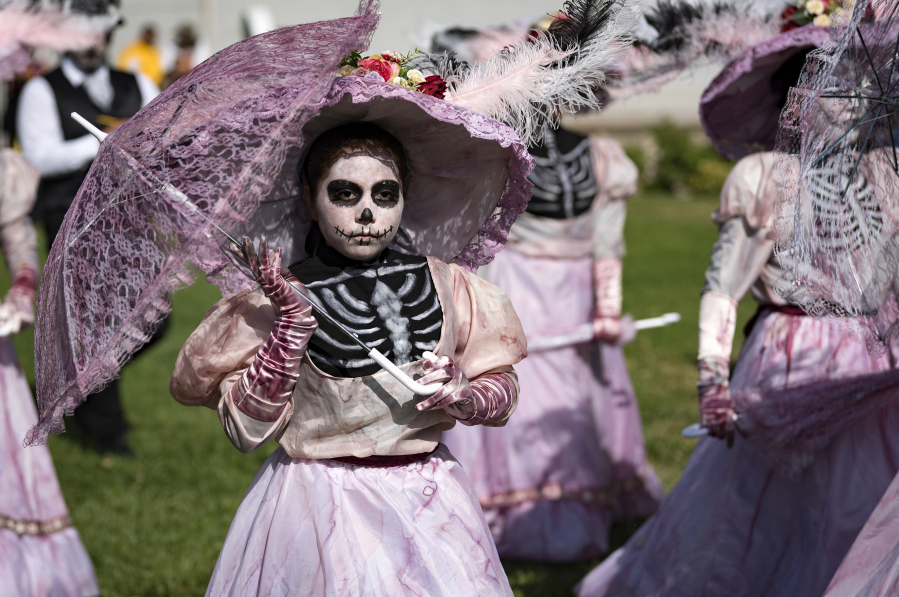LOS ANGELES — As thousands prepared to head to Hollywood Forever Cemetery Saturday for its 18th annual celebration of the Mexican tradition known as Dia de los Muertos, there were places to shop.
Outfits adorned with images of colorful sugar skulls, skeletons and other traditional Day of the Dead symbols are available far beyond the small neighborhood stores that once had a lock on such things.
Target, Wal-Mart and other big retailers have plastered the theme on masks, paper plates and candle holders. There are Day of the Dead earrings and necklaces at Party City, costumes and headbands at Spirit Halloween stores and temporary tattoos and bed covers available at Etsy.com.
Merchandise capitalizing on the tradition had been spreading rapidly in the retail world in recent years, but this year it seems to be everywhere, even stamped on the California Lottery’s “Dia de los Muertos Scratchers.”
The Hollywood Forever Cemetery event was just one of 19 Day of the Dead festivities across greater Los Angeles. Day of the Dead also is the underlying concept of a new Pixar animated movie, “Coco,” that’s being heavily marketed ahead of its Nov. 22 release.
Some point to another movie, 2015’s James Bond film “Spectre,” for helping propel the Day of the Dead momentum because it includes an elaborate Dia de los Muertos parade in Mexico City.
As a result, Day of the Dead — largely celebrated Nov. 1 and 2 — effectively has become rolled up into the Halloween retail juggernaut, unsettling some observers who see it as cultural appropriation that turns the centuries-old Day of the Dead remembrances into crass commercialism.
The melding together of Halloween and Day of the Dead is becoming more apparent.
Nearly 180 million Americans this year are expected to spend a record $9.1 billion on Halloween, a 32 percent surge from just two years ago, according to the National Retail Federation.
The trade group doesn’t yet track Day of the Dead sales alone, but “we wouldn’t be surprised if it becomes mainstream by next year, especially after movies like ‘Coco’ are released,” federation spokeswoman Ana Serafin Smith said. “Movies influence what a lot of people want to dress up as on Halloween.”
Day of the Dead merchandise “has been a popular style” for Party City since it began carrying the products three years ago, said Ryan Vero, president of Party City’s retail division, which operates 900 U.S. outlets. “We even dedicated a section in our stores for this merchandise,” he said.
Day of the Dead products are “dramatically more visible to me this year,” said Charlene Villasenor Black, a professor of Ibero American Art and Chicana-Chicano Studies at UCLA. “The melding together of Halloween and Day of the Dead is becoming more apparent.”
The ever-growing Halloween retail phenomenon is even encroaching on Christmas turf. Some Halloween buffs are buying bright-orange fake Christmas trees and adorning them with skulls, skeletons and candy to create Halloween trees.
The jump in Halloween spending not only is a bright spot for retailers but an offbeat economic indicator because its growth generally has tracked the economy’s expansion and rising consumer confidence.
The National Retail Federation’s spending survey, conducted with Prosper Insights and Analytics, showed that only 12.9 percent of respondents said current economic conditions would affect their Halloween spending this year. That figure was 32.1 percent six years ago, when the economic recovery was stumbling.
Dia de los Muertos goes back thousands of years. Much of the holiday is aimed at celebrating life along with remembering the dead.
The event traditionally consisted of family gatherings that often were held at the gravesites of the departed. Altars, or ofrendas, also were created in survivors’ homes with photos and favorite objects of dead loved ones.
Day of the Dead’s rising popularity in Southern California is seen as occurring in lockstep with the region’s growing Latino population, a consumer segment the retail industry naturally wants to capture.
But there’s been a backlash in some quarters.
A recent article on style website Bustle.com listed the Day of the Dead sugar-skull mask or face painting as one of eight costumes that “are actually racist, even if you might not realize it” unless one was raised in Mexican culture and observes Dia de los Muertos.
The website Latina.com listed Dia de los Muertos as one of seven things “Mexicans did before it was cool” and that the holiday “has become fodder for cultural-appropriating Americans.”
Pixar parent Walt Disney Co. also ran into controversy as it developed plans for “Coco.” Disney tried to trademark “Dia de los Muertos” in 2013 but withdrew the application after a public uproar that accused Disney of cultural insensitivity.
Certain universities also are urging students to avoid Halloween costumes in general that some might deem offensive because they reflect ethnic stereotypes or are culturally insensitive and disrespectful.
Villasenor Black said she too was “more conscious of the issue of appropriation” with Day of the Dead merchandise.
“I am wondering about the commercialization” of the tradition at the same time “Latinos and Mexicans are under fire, really, in the United States,” she said, in part because of the heightened national dispute about immigration.
“There’s a tension in my mind,” she said.



